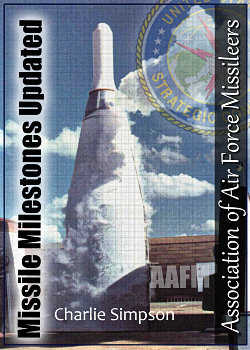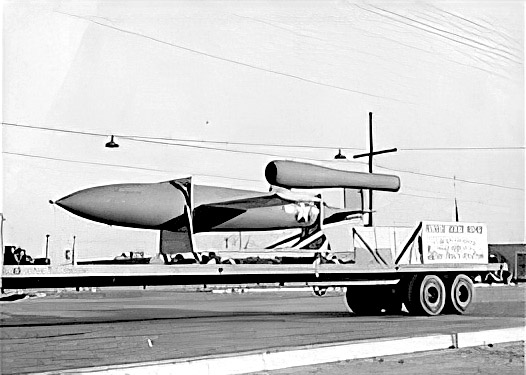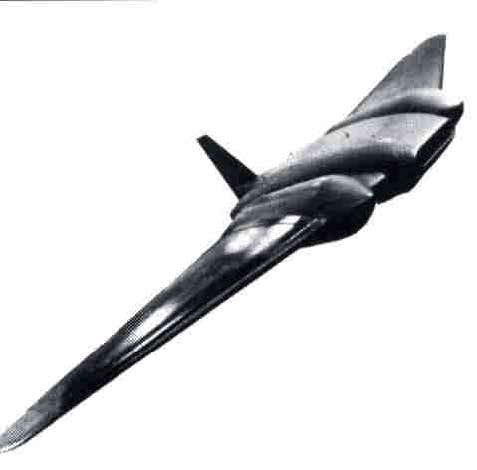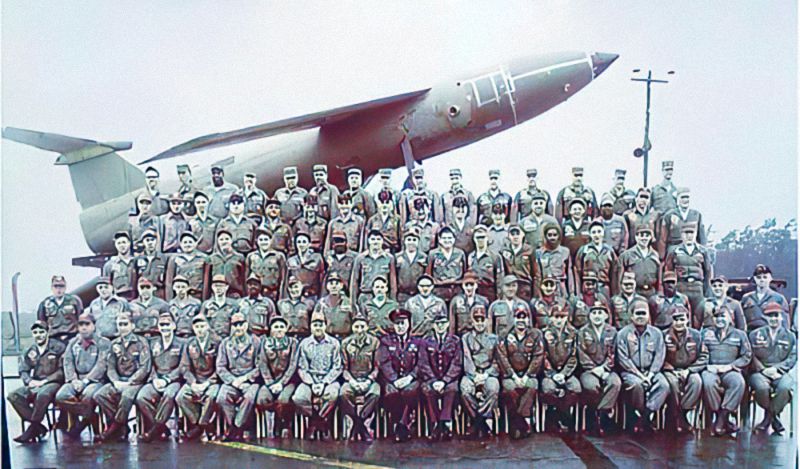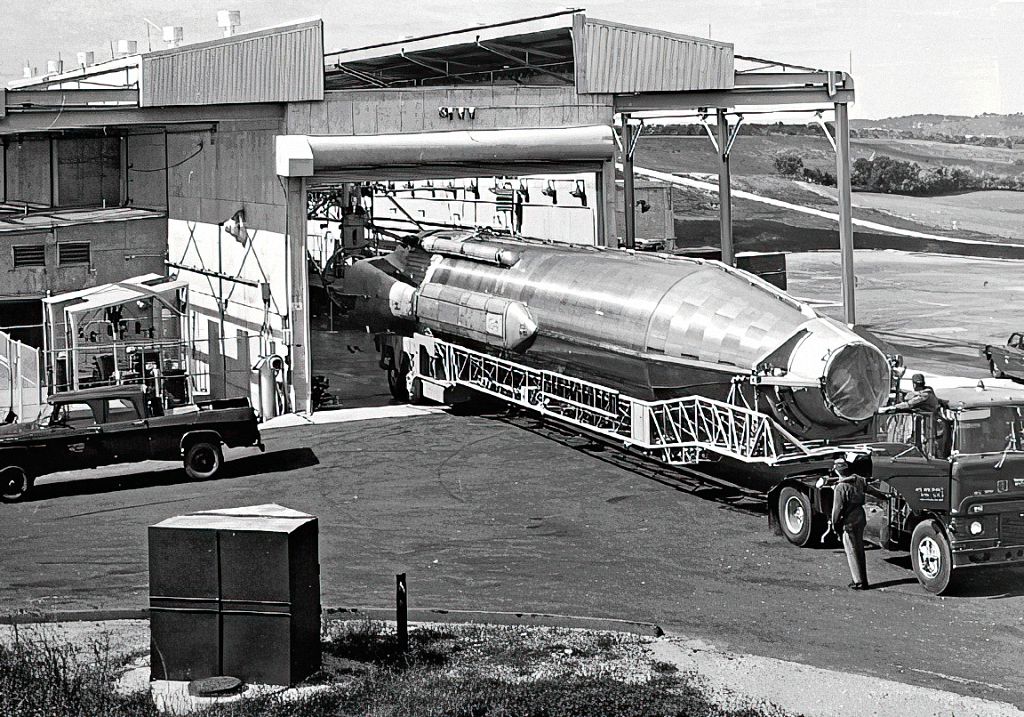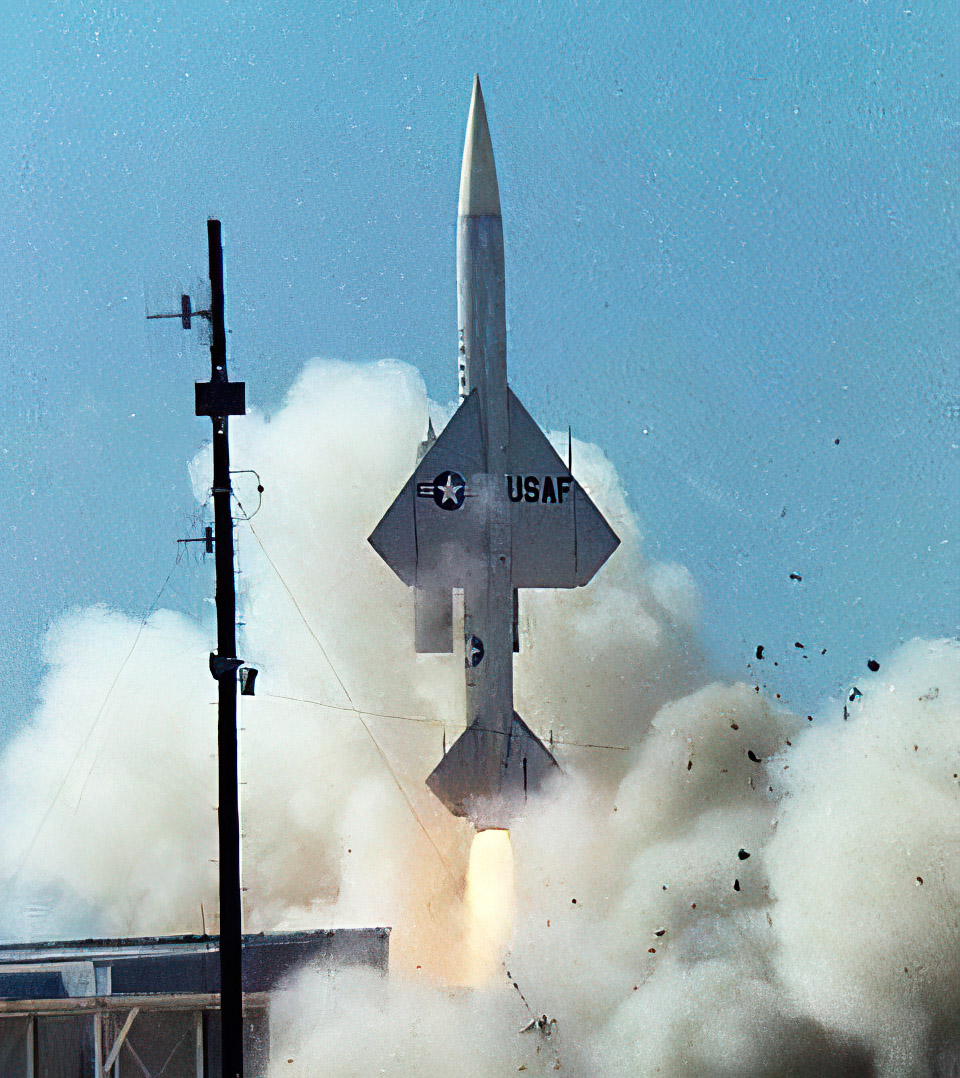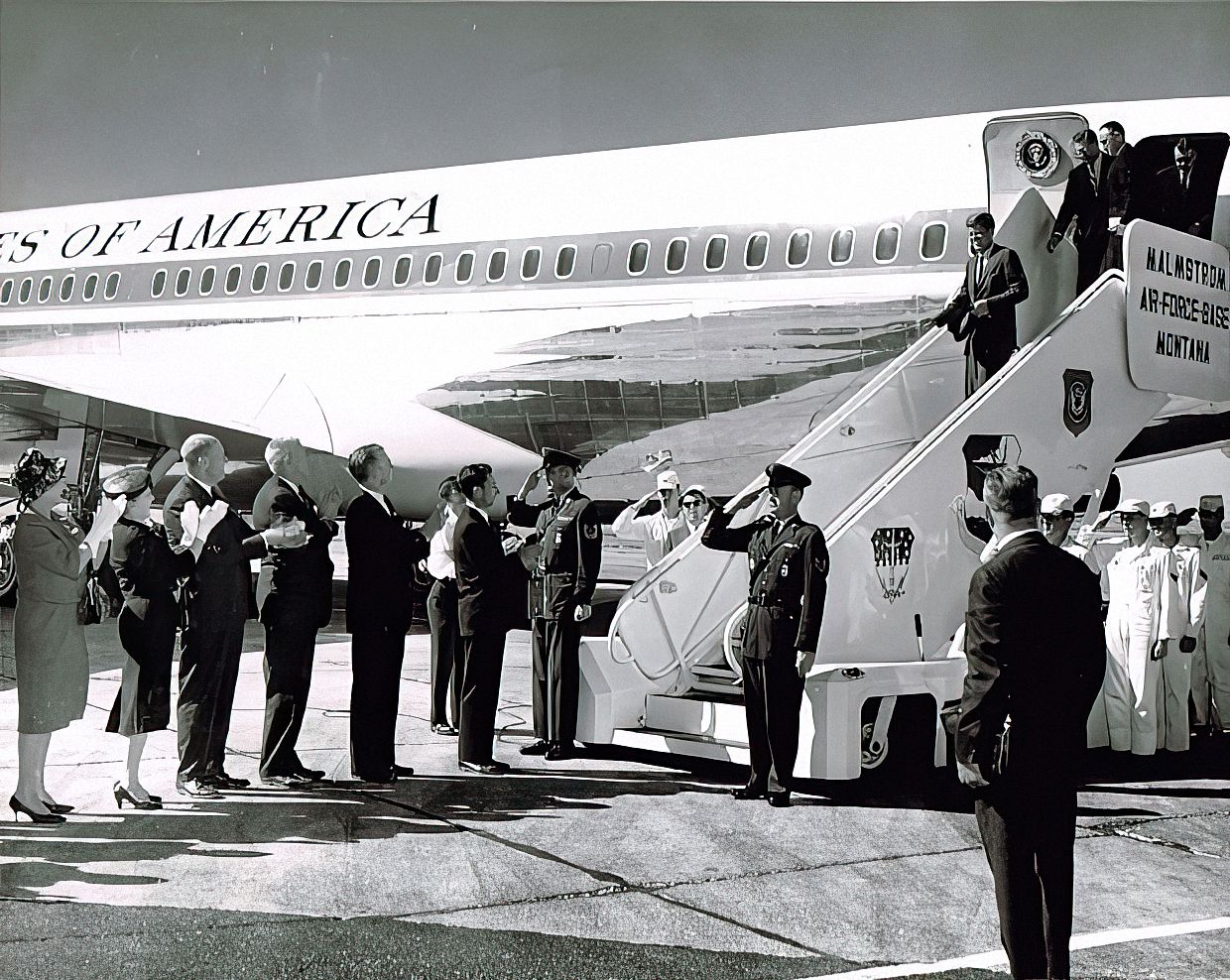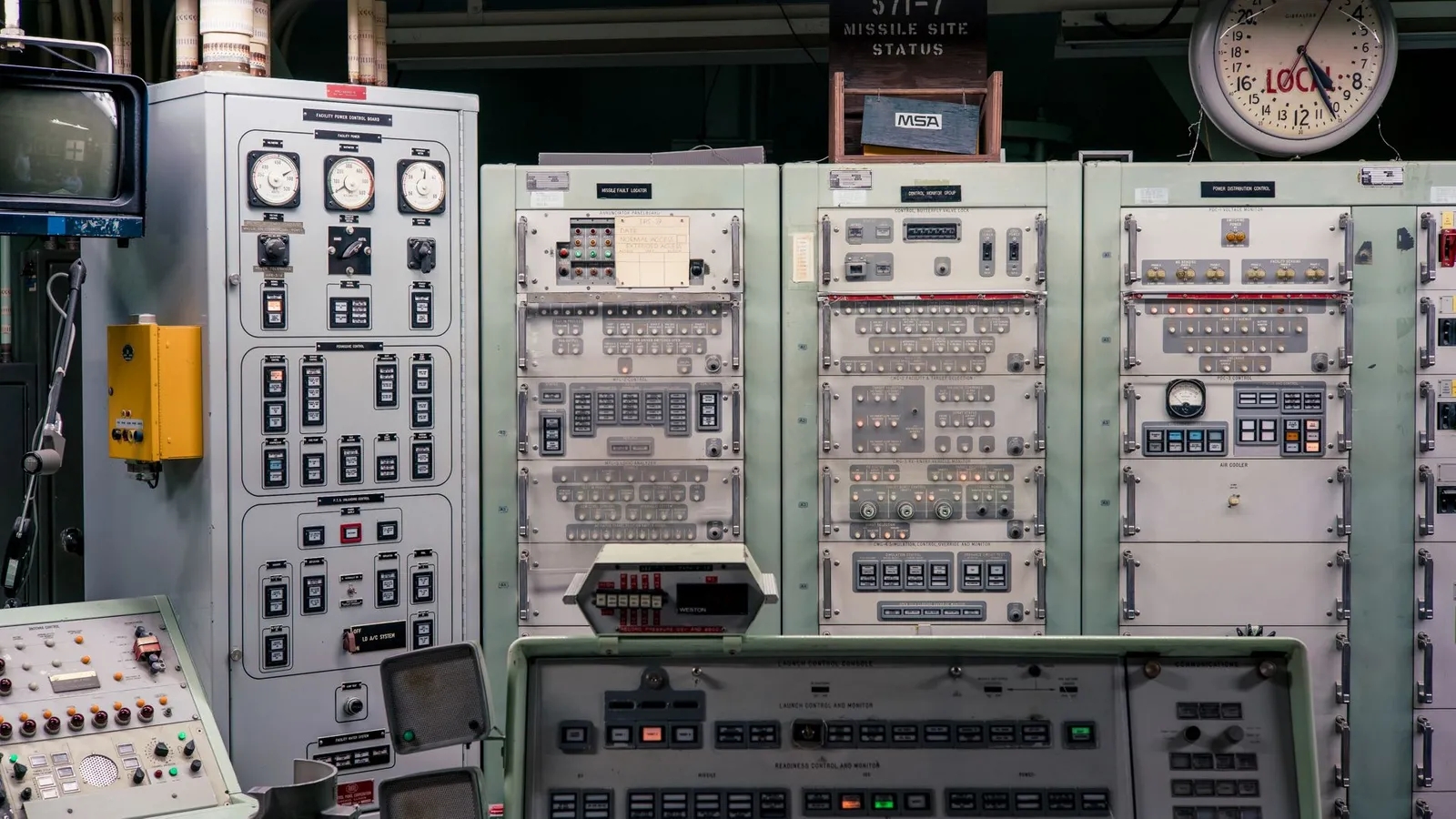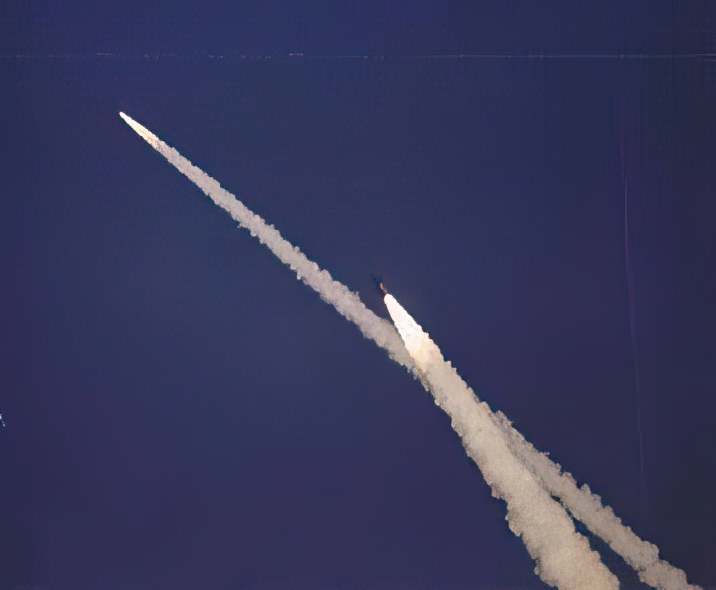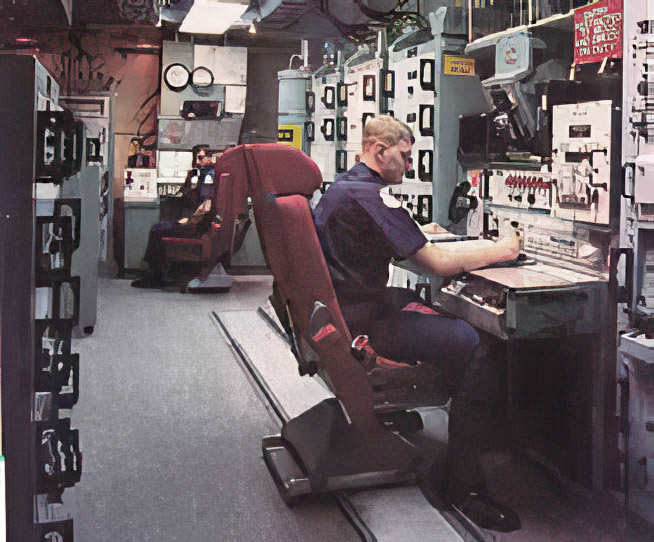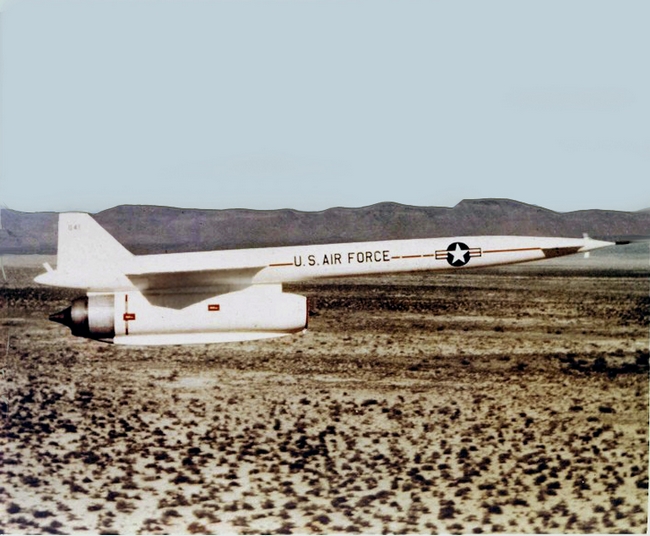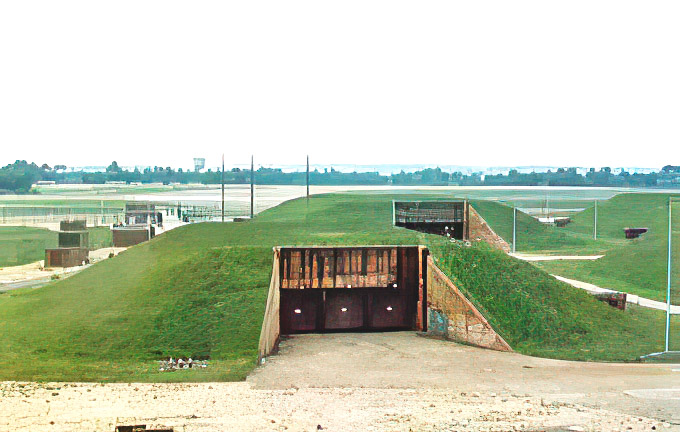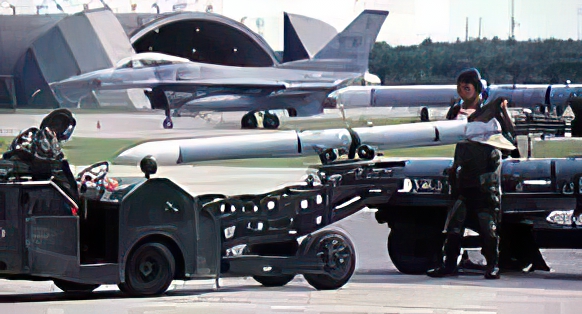|
|
|
|
|
Charlie Simpson
© «AAFM», September, 2019.
Our address: en@rvsn.info |
|
See also: «AAFM», September 2019. Newsletter of «Association of Air Force Missileers»
This list reflects the history of Air Force missiles and missileeers, from the beginning concepts to the latest plans for Air Force systems, programs and events. It was assembled from various history publications, other documents and publications in the AAFM library and many other sources. You will find many historical articles and personal stories in our newsletter collection on our web page, complete with an index of all articles. If we missed an important event or program note, let us know.
Late 1944 – Production begins on the US version of the German V-1 cruise missile, called the JB-2 Loon. Over 200 are flight tested by August 1945. December 1944 – First JB-1 flying wing cruise missile built by Northrop flight tested. Program terminated in March 1946. September 1945 – JB-2 Loon production terminated after 1391 produced by Ford and Willys Overland. April 1946 – Army Air Force (AAF) has 12 surface to surface and 3 surface to air missile programs underway, including Nativ, Navaho, Matador, Hiroc, Snark, Boojum, Banshee, GAPA, Condor, Wizard and Thumper. Programs were designates MX, with Matador designated MX-771A.
19 April 1946 – AAF awards contract to Convair to study a 1500-5000 mile surface to surface subsonic or supersonic missile, the MX-774. 1946 – 1st Experimental Guided Missile Group forms at Eglin AAF, FL. June 1947 – AAF cancels contract with Convair due to reduction in missile development funds – Convair continues work on MX-774 on its own. July 1947 – AAF narrows missile programs to Navaho, Matador, Boojum, Banshee, GAPA and Wizard. Early 1950 – Boeing Airplane Company (BO) and the Michigan Aeronautical Research Center (MARC) begin to develop the BOMARC air defense missile. 19 January 1949 – First launch of the XSSM-A-1, the Matador prototype, at Holloman AFB, NM. The first test was a failure due to booster misalignment. The second launch, a few days later, was successful. 20 June 1949 – 1st Experimental Guided Missile Group replaced by the 550th Guided Missile Wing. 29 August 1949 – Soviets detonate their first nuclear bomb. 21 December 1950 – First test of a dummy Snark missile at Holloman by a Northorp Field Test Crew. 16 June 1951 – US Air Force awards contract to Convair to study a rocket powered glide or ballistic missile with a range of 5,500 nautical miles, a circular error probable of 1,500 feet and the capability to carry an atomic weapon. September 1951 – Air Force directs Convair to work only on a ballistic system. January 1951 – Convair names its program Atlas. May 1952 – The first model N-25 Snark missile arrived at Patrick AFB, FL. 19 July 1952 – 6555th Guided Missile Squadron (GMS) activated for the Snark system.
May 1952 – First Navaho test vehicles delivered to Edwards AFB, CA. 10 September 1952 – First BOMARC A launched at Cape Canaveral, FL. 13 October 1952 – Quail missile program, GAM-72/ADM-20, begins to develop a decoy missile to be carried by the B-52. 1 October 1953 – First Navaho X-10 tested at Edwards. 1 October 1951 – 1st Pilotless Bomber Squadron (PBS) activated at Patrick AFB, FL, for Matador. 10 January 1952 – The 69 PBS activated, the second operational missile units in the Air Force equipped with the B-61A Matador. September 1953 – AIM-9A, Sidewinder prototype first fi red successfully. 1954 – AF Vice Chief General White assigns Project Atlas the highest AF priority. 1954 – Falcon Gar-1/AIM-4 air to air missile tested for the first time. 8 February 1954 – A RAND report states that Atlas can be operational by the early 1960s. 9 March 1954 – 1 PBS assigned to Bitburg AB, Germany, with Matador missiles on alert shortly after arrival. July 1954 – The B-73, initially called the Bull Goose, a ground launched decoy missile to simulate bombers, assigned project MX-223, with the name changed to Goose in May 1958. 1 July 1954 – Western Development Division (WDD), under command of Maj Gen Bernard Schriever, activated with responsibility for and total authority over Atlas development. 1 October 1954 – 69 PBS arrives at Hahn AB, Germany. 31 October 1954 – The Von Neumann committee is formed to do a “searching analysis” of the Air Force Intercontinental Ballistic Missile (ICBM) program. A recent breakthrough by the Atomic Energy Commission for a high yield, light weight atomic weapon allows the committee to recommend that technological difficulties could be overcome and the Air Force should accelerate the development program. May 1955 – WDD assigned responsibility for Titan, an alternative or backup ICBM to Atlas. 8 September 1955 – President Eisenhower assigns the highest national priority to the ICBM development program. 18 November 1955 – WDD tasked with establishing an Initial Operational Capability (IOC) for the ICBM program in cooperation with Strategic Air Command (SAC), with WDD retaining all responsibilities until IOC, when the responsibilities are transferred to SAC. 1956 – Sidewinder initial production version, designated AIM-9B, enters the Air Force inventory. 16 July 1956 – 1st Missile Division moved to Camp Cooke. 1 September 1956 – Camp Cooke designated as Intermediate Range Ballistic Missile (IRBM)/ICBM base. 1 June 1957 – Camp Cooke becomes Cooke AFB, CA 17 June 1957 – 17 Tactical Missile Squadron (TMS), Matador squadron activated at Tainan, Taiwan. 19 July 1957 – First launch of the Genie MB-1/AIR-2, an air defense missile designed to counter Soviet bombers, with either a conventional or nuclear warheads, from an F-89J. 13 July 1957 – Navaho program canceled so Air Force could concentrate on ballistic missiles rather than aerodynamic systems, although testing continued for research purposes. 23 August 1957 – Headquarters USAF awards North American Aviation a development contract for the Hound Dog air to surface missile. 1 October 1957 – Snark N-69Ds launched by the 6555 Guided Missile Test Wing, the first blue suit launch. 15 December 1957 – The 556th Strategic Missile Squadron (SMS) activated under the command of Lt Col Richard W. Beck at Patrick, as the Snark operational unit. 1 January 1958 – Cooke AFB moves from Air Research and Development Command (ARDC) to SAC. 8 May 1958 – First Atlas ICBM delivered. 4 October 1958 – Cooke AFB becomes Vandenberg AFB. 16 December 1958 – First missile launched at Vandenberg – a Thor IRBM. December 1958 – Goose program canceled. 23 May 1958 – Missile badge authorized June 1958 – Construction begins on Atlas ICBM launch and support facilities at the 706 SMW (later the 389 SMW) at FE Warren AFB, WY. 1 July 1958 – 564 SMS (Atlas D) at Warren activated.
July 1958 – Chief of Staff of the Air Force awards the first two Guided Missile Insignia (later renamed the Missile Badge) to Col Erlenbusch and MSgt Kindsfather. 15 July 1958 – 58 Tactical Missile Group (TMG) activates at Osan AB, Korea, with Matador missiles. 26 September 1958 – SAC awards the first two missile badges to Capt Loughbridge and MSgt Mustaine. 18 November 1958 – Final flight for the Navaho G-26. Every test failed somewhere in the flight, with the ninth flight the longest, with the ramjets reaching a speed of Mach 2.8 and traveling over 1,075 miles downrange. 2 August 1958 – First successful launch of Series B Atlas ICBM (booster and sustainers) from Cape Canaveral marked first successful staging (stage separation) of US ICBM. 6 August 1958 – Development of the Minuteman ICBM approved by Air Force. 1 September 1958 – First Royal Air Force (RAF) US Air Force Thor squadron, the 77 SMS, activated at RAF Feltwell, UK. 25 September 1958 – First Titan I ICBM wing activated. 28 November 1958 – First full-range flight test success of Atlas B ICBM with flight 5,500 nautical miles from Cape Canaveral. 1 December 1958 – 565 SMS (Atlas D) at Warren activated. 23 December 1958 – First successful Atlas C ICBM launch from Cape Canaveral. 1 January 1959 – SAC activates the 702nd Strategic Missile Wing (SMW) (ICM-Snark) at Presque Isle AFB, ME. (ICM – Intercontinental Cruise Missile) 6 February 1959 – First successful Titan I ICBM launch from Cape Canaveral. 12 February 1959 – SAC sets requirements for mobile Minuteman using railcars. 26 March 1959 – 576 SMS accepts delivery of first Atlas D at Vandenberg. April 1959 – 556 SMS at Patrick assigned to the 702 SMW. 23 April 1959 – A B-52 launches the first flight test of a prototype Hound Dog missile at Eglin. December 1959 – The first Hound Dog-equipped B-52G unit is the 4135th Strategic Wing (StratW), Eglin. May 1959 – First BONARC B launched. 15 July 1959 – The 556 SMS inactivated and absorbed into the 702 SMW. 28 July 1959 – First successful launch of Atlas D ICBM at Cape Canaveral. 9 September 1959 – Following first successful launch of Atlas D from Vandenberg, Gen Thomas S. Power, Commander in Chief, SAC (CINCSAC), declares Atlas operational. 28 September 1959 – First Atlas D deployed to 564 SMS at Warren. 31 October 1959 – First US ICBM equipped with nuclear warhead, Atlas D at Site A, on alert at Vandenberg. 21 December 1959 – Gen Thomas Power, CINCSAC, accepts the first production Hound Dog Missile at the North American Aviation’s Downey, CA, plant. 29 February 1960 – SAC launches its first Hound Dog missile. 18 March 1960 – 702 SMW placed the first Snark on alert, 11 April 1960 – A B-52 took off from Eglin carrying two operational Hound Dogs, and flew to Florida’s east coast, where one of the missiles was launched over the Atlantic Missile Range. 3 June 1960 – First Thor IRBM and its warhead mated in the 77 RAF SMS at Feltwell. 11 July 1960 – First Jupiter IRBM emplaced at an Italian missile base. 9 August 1960 – First Atlas D squadron, 564 SMS at Warren, declared operational. 13 September 1960 – First Quail missile delivered to the 4135th Strategic Wing, Eglin. 19 September 1960 – First BOMARC squadron, the 46th Air Defense Missile Squadron (ADMS) at McGuire AFB, NJ, attains operational status.
28 February 1961 – The 702 SMW declared “operational.” 28 March 1961 – President Kennedy declares the Snark “obsolete and of marginal military value,” 3 February 1961 – First flight of Looking Glass, SAC’s 24 hour Airborne Command Post. 8 February 1961 – 498 TMG, with Mace missiles, activated at Kadena AB, Okinawa. 30 March 1961 – Last Atlas D squadron, 549 SMS (originally designated the 566 SMS) at Offutt, declared operational. May 1961 – the last Atlas D, in the 549 SMS on alert. May 1961 – The AGM-28B, an advanced version of the Hound Dog, first flies. It incorporates an improved Flight Control system using Terrain Following equipment and had greater range. 3 May 1961 – First Titan I launch from Vandenberg by an Air Force Systems Command (AFSC) crew. 11 May 1961 – Last Matador launch at Patrick. June 1961 – The first launch of a AGM-28 Hound Dog Missile from White Sands Missile Range, NM. (A total of 17 were launched there between 1961 and 1967.) 1 June 1961 – First BOMARC B squadron, the 37 ADMS, operational at Kincheloe AFB, MI. 25 June 1961 – SAC inactivates the 702 SMW and by July 1962 all missiles have been destroyed. 1 July 1961 – SAC MIKE at BMD closed. 1 July 1961 – the 3901st Strategic Missile Evaluation Squadron activated at Vandenberg.
15 July 1961 – 341 SMW, the first Minuteman wing, activated at Malmstrom AFB, MT. 25 August 1961 – The first Hound Dog missile delivered to Beale AFB, CA, and mated to a B-52 on 2 September 1961. October 1961 – first Atlas E on alert, 567 SMS, Fairchild AFB, WA. November 1961 – All Atlas E missiles except those used for training on alert in the 567 SMS, Fairchild, 548 SMS, Forbes AFB, KS, and 389 SMW, Warren. 7 November 1961 – First Jupiter IRBM in Turkey manned by US personnel while training Turkish crews. 20 November 1961 – final Atlas E squadron, 566 SMS (initially designated the 549 SMS) at Warren, declared operational. 7 December 1961 – Mobile Minuteman canceled. 8 December 1961 – Combat Evaluation Launches begin at Eglin by elements of the B-52G equipped 4241 StratW, Seymour Johnson AFB, NC. 1962 – SAC activates Airborne Missile Maintenance Squadrons at each B-52 base to provide the maintenance for the Hound Dog and its sister missile, the Quail. 9 January 1962 – Under Operation “Jetblack”, the first SAC Combat Evaluation Launch of a GAM-77 Hound Dog missile was made. A B-52G crew from the 4126 SW, Beale AFB, CA, launched the missile down the Atlantic Missile Range. The missile flew 607 nautical miles and impacted a target down range. 17 January 1962 – The 4038 StratW at Dow AFB, ME, with B-52Gs, became the first SAC unit to carry Hound Dog missiles on Strategic Airborne Alert (Chrome Dome) missions.
20 January 1962 – First Titan I launch by a SAC crew. 20 April 1962 – first Titan I squadron operational, 848 SMS (redesignated the 742 SMS), in the 703 SMW (redesignated the 451 SMW) at Lowry AFB, CO. 6 August 1962 – Last Titan I squadron, 569 SMS at Mt Home AFB, ID, operational. 1 April 1962 – First Titan II squadron, 570 SMS at Davis Monthan AFB, AZ, activated. 15 April 1962 – Quail missiles delivered to the fourteenth and last bomb wing to receive them. August 1962 – First Atlas F on alert, 577 SMS, Altus AFB, OK.. 9 September 1962 – Atlas F squadron, 550 SMS at Schilling AFB, KS, operational. September 1962 – Last of the six Titan I squadrons, 851 SMS, Beale, on alert.
28 September 1962 – First Minuteman I launch by a SAC crew. 22 October 1962 – SAC bombers and missiles put on increased alert due to Cuban Missile Crisis. All remaining Atlas F missiles not yet on alert are rushed to alert. 27 October 1962 – Minuteman I missiles of A Flight, 10 SMS, Malmstrom rushed to alert during Cuban crisis. November 1962 – Minuteman Education Program starts at Malmstrom. 11 December 1962 – First two flights of Minuteman I in 10 SMS at Malmstrom operational, 20 December 1962 – Last Atlas F squadron, 556 SMS at Plattsburgh AFB, NY, operational. 1963-1964 – Project Red Heat (Atlas) and Top Banana (Titan I) upgrade modification programs implemented at Atlas F and Titan I sites. 1963 – Two new versions of the Missile Badge introduced, the Senior and Master badges. 24 January 1963 – President Kennedy announces the phaseout of Jupiter missiles in Turkey and Italy. 18 February 1963 – The first attempted dual launch of Hound Dog missiles in the Atlantic Missile Range successful. 28 February 1963 – First Minuteman squadron, 10 SMS at Malmstrom operational. 28 Mar 1963 – North American Aviation completes the last production Hound Dog missile. April 1963 – First Titan II on alert, 570 SMS, Davis-Monthan. 15 May 1963 – 4315th Student Squadron redesignated as the Combat Crew Training Squadron (CCTS), absorbing the training functions previously under the 576 SMS (Atlas), 394 Missile Training Squadron (MTS) (Minuteman) and 395 MTS (Titan). The 394 and 395 redesignated SMS. 8 June 1963 – First Titan II squadron, 570 SMS at Davis- Monthan, operational. July 1963 – First Minuteman IB model on alert, 66 SMS, Ellsworth AFB, SD. 31 December 1963 – Last Titan II squadron, 374 SMS at Little Rock, operational. 23 August 1963 – Last Thor squadrons deactivate at RAF North Luffenham, UK. 23 November 1963 – Air Force approves program for a Short Range Attack Missile (SRAM). 29 February 1964 – First ripple launch of two Minuteman I missiles from Vandenberg, by crews from the 10 SMS. 21 April 1964 – Number of ICBMs on alert equals the number of bombers on alert. 16 May 1964 – McNamara announces phaseout of Atlas and Titan I to be complete by the end of FY 1965. 1 October 1964 – Last Atlas D removed from alert to complete Atlas D phaseout. 1 March 1965 – Project Long Life, a seven second long flight of a Minuteman I launched from an operational base silo at Ellsworth, the only successful operational base launch. 23 March 1965 – Development of the SRAM, AGM-69A, approved. 12 April 1965 – Last Atlas F off alert, completing phaseout of the Atlas D, E and F and Titan I. Mid 1965 – SAC changes Minuteman crew structure to three man crews since crew members will no longer be allowed to sleep in the launch control center. 30 August 1965 – The last launch of a AGM-28 Hound Dog over the Atlantic Test Range. There were 77 launches from 1959 thru 1965. 31 October 1965 – First flight of Minuteman II, 447 SMS, Grand Forks AFB, ND, on alert. February 1966 – Mace replaces Matador in Okinawa and Matador missiles leave Korea and Taiwan. 24 February 1966 – First salvo launch of two Minuteman I missiles from Vandenberg. 2 April 1966 – 576 SMS, the last Atlas squadron inactivated. 25 April 1966 – First Minuteman II Squadron, 447 SMS at Grand Forks operational.
7 May 1966 – Force Modernization of Minuteman I begins at Whiteman AFB, MO. 25 September 1966 – The Mace missile program ends in Germany with the deactivation of the 38th Tactical Missile Wing (TMW). 16 October 1966 – The second attempt to launch a modified missile from an operational silo is attempted at one of the Grand Forks launch facilities. This attempt and two others, titled Long Life II and then Giant Boost, fail due to problems with the safety circuits installed for the launches. 1967 – Foil Packs replace cooked meals at Minuteman launch control facilities due to a shortage of cooks caused by the war in Vietnam. 3-7 April 1967 – Curtain Raiser, the first SAC Missile Combat Competition, conducted at Vandenberg. 17 April 1967 – First Airborne Launch Control System (ALCS) launch of a Minuteman missile. 21 April 1967 – Last Minuteman squadron, the 564 SMS at Malmstrom operational. 31 May 1967 – ALCS declared operational. Mid-1967 – Two piece blue alert uniforms replace white coveralls.
October 1967 – The Emergency Rocket Communications System (ERCS) is operational in the 510 SMS at Whiteman. 1968 – SAC Missile Combat Competition canceled due to Vietnam involvement by SAC. 29 June 1968 – Survivable Low Frequency Communictions System (SLFCS) fully operational. 12 February 1969 – Last Minuteman LGM-30A removed. 17-24 May 1969 – Olympic Arena, the second SAC Missile Combat Competition conducted at Vandenberg. October 1969 – The last Mace missile, a CGM-13B, is taken off alert at Kadena in the 498th TMG. 31 December 1969 – 395 SMS (Titan) at Vandenberg inactivated and 394 SMS absorbs Titan capabilities. Early 1970 – Decision made to close down the entire air defense missile system including BOMARC. 17 April 1970 – First Minuteman III emplaced in the 741 SMS at Minot AFB, ND. 19 August 1970 – First Minuteman III on alert, 741 SMS, Minot. 25 March 1971 – Last Launch from White Sands Test Range of a AGM-28B, missile SN 62-0139 from Robins AFB, GA.
29 December 1970 – First Minuteman III squadron, the 741 SMS at Minot, operational. 1972 – SAC begins deploying the SRAM and phasing out the Hound Dog. August 1972 – First AGM-65A Maverick accepted. 15 September 1972 – First bomb wing receives the SRAM, the 42 Bomb Wing (BW), Loring AFB. ME. 1 October 1972 – Last BOMARC missile at McGuire, removed, ending the operational life of the system. 24 July 1973 – The last Hound Dog operational test at the Eglin water test area. February 1974 – Air Force enters into contract to develop and fl ight-test the prototype AGM-86A Air Launched Cruise Missile (ALCM), which is slightly smaller than the later B, C and D models. 30 June 1975 – After thirteen years of alert duty in SAC, the last Hound Dog missile removed from Alert Status. Note: The 416 BW did not complete weapons package changeover until after 1800Z on 1 July due to a unscheduled aircraft change over – HQ SAC refused to reconfigure the remaining aircraft until the changeover was complete. The last B-52G on alert with AGM-28 Hound Dog missiles at Griffiss AFB, NY, was B-52G SN 59-2585. 5 March 1976 – First powered flight of the ALCM, AGM- 86A. 28 June 1976 – Last Titan II ICBM launch, to test the Rivet Hawk AC-Delco guidance system. The new system replaces the original guidance system in the Titan II force. January 1977, – Full-scale development of the AGM-86B ALCM, which greatly enhances the B-52’s capabilities’. May 1977 – Last Mace missile, MQM-13A, launched by the 4751 ADMS at Hurlburt Field, FL, the last of 165 Mace launches there. The CGM missiles had been redesignated MQM drones for use as targets at Eglin.
December 1977 – AIM-9J, a conversion of the AIM-B and E models, with maneuvering capability for dogfighting, and greater speed and range, begins delivery to equip the F-15 and other Sidewinder-compatible aircraft. 31 March 1978 – Project Rivet Save completed, allowing one crew member to sleep resulting in a return to 24 hour alerts and reduction of 600 crew members in Minuteman. 15 June 1978 – The 42 BW, Loring, destroys the last Hound Dog missile in the SAC inventory. 30 June 1978 – Last Quail missile removed from alert. 18 August 1978 – first alert by an enlisted female crew member, Titan II, 381 SMW, McConnell AFB, KS. 16 September 1978 – first alert by an female officer crew member, Titan II, 381 SMW. February 1979 – Air Force selects Hughes Aircraft and Raytheon, for the validation phase of the AIM-120 advanced medium-range air-to-air missile (AMRAAM), an air-to-air missile with an all weather, beyond-visual-range capability. 18 September 1980 – The Titan II missile complex at Damascus, AR, part of the 308 SMW at Little Rock AFB, AR, is destroyed in an explosion. One Air Force member dies as a result of the accident. 1981 – Hughes Aircraft’s Missile System Group selected as the full-scale developer for AAMRAM. 11 January 1981 – First ALCM delivered to the 416th Bomb Wing, Griffiss. 14 September 1981 – Last SAC Thor booster departs Vandenberg for storage at Norton AFB, CA. December 1982 – AIM-7 Sparrow, radar-guided, air-to-air missile with a high explosive warhead enters service. The versatile Sparrow has all-weather, all-altitude operational capability and can attack high performance aircraft and missiles from any direction. It is a widely deployed missile used by US and North Atlantic Treaty Organization forces. 1 July 1982 – The first GLCM wing, the 501 TMW at Greenham Common, UK, opens. 14 July 1982 – Last BOMARC launched from Vandenberg. A total of 26 BOMARC A and 31 BOMARC B missiles were launched from Vandenberg. August 1982 – The first Titan II missile is called off alert at Davis-Monthan. The site had been off alert for modification since July and was permanently taken off alert as the first missile in Titan II phaseout. 2 October 1982 – President Reagan announces deployment of Missile-X, later designated Peacekeeper, with at least 36 to be deployed to refurbished Titan II or Minuteman silos. President Reagan also announces phaseout of Titan II. November 1982 – President Reagan announces M-X (now designated Peacekeeper) basing to be at Warren in the “Dense Pack” basing mode.
1983 – Convair selected to develop the AGM-129 Advanced Cruise Missile (ACM). 30 June 1983 – The second GLCM wing, the 487 TMW at Comiso, Sicily, opens. March 1983 – Defense Systems Acquisition Review Council approved the AGM-88, a high-speed anti-radiation missile, an air-to-surface tactical missile designed to seek and destroy enemy radar-equipped air defense systems, for production. October 1983 – First AGM-65D accepted. 1984 – Development of the AGM-130 initiated as a product improvement to the GBU-15 guided glide bomb system. AGM-130 is a powered, air-to-surface missile designed for high- and low-altitude strikes at standoff ranges against a variety of targets. 1 August 1984 – The third GLCM wing, the 485 TMW at Florennes, Belgium, opens. 4 February 1985 – Gen Davis, CINCSAC, announces that future Minuteman and Peacekeeper crews would include all female as well as all male crews, a “gender specific” manning policy. 1 March 1985 – 15th Air Force (AF) requires missile squadron commanders and operations officers to perform alert. 1 April 1985 – The fourth GLCM wing, the 38 TMW at Wuscheim, Germany,, opens. 3 January 1986 – First Minuteman III removed from the 400 SMS at Warren to be replaced by the new LGM-118A Peacekeeper missile. 25 March 1986 – First female crew members on alert in Minuteman at Whiteman. 12 December 1986 – The fifth GLCM wing, the 303 TMW at Molesworth, UK, opens.
June 1986 – Limited number of AGM-86B missiles converted to carry a high-explosive blast/fragmentation warhead and an internal GPS, designated as the AGM-86C Conventional Air Launched Cruise Missile (CALCM). 22 December 1986 – First flight of Peacekeeper on alert, 400 SMS, Warren. 5 May 1987 – Last Titan II removed from alert, 373 SMS, Little Rock. 18 August 1987 – Last Titan II Wing, the 308 SMW at Little Rock, deactivated. 27 August 1987 – The sixth and last GLCM wing, the 486 TMW at Woendsdrecht, Netherlands, opens. 4 December 1987 – One piece blue alert uniform approved. 1988 – Operations Designator introduced for the Missile Badge to differentiate between operators and maintainers. March 1988 – Crew members authorized wear of the leather jacket. April 1989 – Joint Air-to-Surface Standoff Missile (JASSM) program begins, 11 April 1988 – Conversion of 400 SMS at Warren from Minuteman III to Peacekeeper complete. 23 July 1988 – First ACM delivered to the 410 BW, KI Sawyer AFB, MI. 1 April 1989 – The 303 TMW, the GLCM wing at Molesworth, UK, closes. 30 April 1989 – The 485 TMW the GLCM wing at Wuscheim, Germany, closes. 24 July 1990 – The Looking Glass ceases 24 hour airborne operations and starts ground alert. 22 August 1990 – The 38 TMW, the GLCM wing at Florennes, Belgium, closes. 9 September 1989 -The 486 TMW, the GLCM wing at Woensdrecht, Netherlands, closes. 21 September 1990 – Col Doug Livingston selected to assemble a group of GLCM veterans to form the 4468th Tactical Reconnaissance Group, tasked with launching BQM- 74C drones as decoys during the Gulf War. January 1991 – The Conventional ALCM (CALCM) becomes operational at the onset of Operation Desert Storm. 27 May 1991 – The 487 TMW, the GLCM wing at Comiso closes. 31 May 1991 – The 501 TMW at Greenham Common, UK, closes, ending the deployment of GLCM in Europe. 1 September 1991 – 20 AF activates at Vandenberg, with all ICBM wings reporting to the Numbered Air Force. September 1991 – The ERCS mission ends. 28 September 1991 – President orders all SAC bombers, tankers, and Minuteman IIs from day-to-day alert. 31 May 1992 – SAC is deactivated, with ICBMs and bombers transferred to the new Air Combat Command (ACC). US Strategic Command (STRATCOM), a joint command responsible for all nuclear forces during wartime, replaces SAC at Omaha. Strategic Missile Wings are redesignated as Missile Wings (MW) and Strategic Missile Squadrons as Missile Squadrons (MS).
1 January 1993 – The Association of Air Force Missileers (AAFM) becomes an official tax exempt, nonprofit Internal Revenue Service Code 501c(3) entity, and begins operation and enrolling members in this new organization for Air Force Missileers. May 1993 – The Missile Competition is conducted at Vandenberg by Air Combat Command. The format was unchanged from earlier SAC competitions. 1 July 1993 – The ICBM force (20 AF, the three missile wings and other related units are transferred from ACC to Air Force Space Command (AFSPC), with headquarters at Peterson AFB, CO. The 4315 CCTS is transferred to Air Education and Training Command and becomes the 392nd Strategic Missile Training Squadron. December 1993 – AAFM begins the Missile Heritage Grant Program, with the first grants to museums for missile displays. 1 April 1994 – The 381st Training Group (TG) takes over all Air Force missile training. 5 May 1994 – First Space and Missile Competition, Guardian Challenge, conducted at Vandenberg. The competition format changes, with a new electronic scoreboard, and with teams from the missile wings and space wings competing. 10 May 1994 – President Clinton directs missiles to be “off target.” 23-26 May 1994 – AAFM conducts its first National Meeting in Colorado Springs, CO. Events include tours and briefings at AFSPC and local area tours. 4 July 1994 – 44 MW at Ellsworth closes. 7 June 1995 – 351 MW at Whiteman closes. 10 August 1995 – Last Minuteman II in the ICBM force removed. 21-25 October 1996 – AAFM conducts its second National Meeting in Santa Maria, CA. Events include tours and briefings at Vandenberg and the local area. 1 October 1997 – The three Missile Wings, become Space Wings (SW) – the 90 SW, 91 SW and 341 SW. March 1998 – Operations personnel are issued leather flying jackets.
May 1998 – AAFM conducts its third National Meeting in Cocoa Beach, FL. Events include tours of the Shuttle launch complex and local attractions. Some members stay a few extra days to watch Senator John Glenn’s Shuttle flight. 30 June 1998 – 321 MG at Grand Forks closes. 17-21 May 2000 – AAFM conducts its fourth National Meeting in Colorado Springs, CO. Events include tours and briefings at Peterson and Schriever AFBs and the local area. 1 October 1998 – Last flight of the Looking Glass command and control aircraft. The mission is assumed by US Navy aircraft. September 2000 – Flight suits replace one piece blue alert uniform. 14 June 2001 – Maintenance personnel from the 90 SW at Warren emplace the inert missile in the new Minuteman Missile National Historic Site, near Wall, SD. The Site includes launch control facility D-01 and launch facility D-09, which will open to the public later in the year. 19 April 2002 – AFSPC becomes a separate command, with the new four star commander, Gen Lance Lord, one of the founders of AAFM, becoming the first career missileer four star. The “second hat” worn by previous AFSPC commanders is assumed by the commander of the new Northern Command, which assumes all the former Aerospace Defense Command functions along with new missions to ensure the defense of the US. 23-27 October 2002 – AAFM conducts its fifth National Meeting in Santa Maria, CA. Events include tours of Vandenberg and local area attractions. 2003 – Guardian Challenge 2003, the AFSPC Space and Missile Competition, is canceled due to the Gulf War. May 2004 – The final Guardian Challenge at Vandenberg, with the competition becoming an “every two year” event, to be conducted at Peterson. Teams will no longer compete during the week of the competition, but will compete at home bases with scores posted at the gathering each two years. Some security and food service events are conducted at Peterson during the week of the competition gathering. 19-23 May 2004 – AAFM conducts its sixth National Meeting in Omaha, NE. Events include tours and briefings at Offutt and yours of local Omaha Attractions. 31 August 2004 – CMSgt (Ret) Michael Kenderes, an AAFM Board Member, inducted into the Air Force Enlisted Heritage Hall. Maj Gen (Ret) Tom Deppe, an AAFM member, and former enlisted member of the Air Force, is the only other missileer in the Hall. 19 September 2005 – Peacekeeper deactivated as 400 MS at Warren and squadron closes. 31 October 2005 – The new Space Badge replaces the Missile Badge with Operations Designator for operators. Maintainers badge is now called the Missile Maintenance Badge. 27 September – 1 October 2006 – AAFM conducts its seventh National Meeting in Cheyenne, WY Events include tours of Warren and Cheyenne attractions. 30 September 2006 – missile crews begin three day alerts. June 2008 – Missile crews return to 24 hour alerts 15 May 2008 – The 564 MS at Malmstrom closes, ending the era of the Sylvania-based Minuteman ground electronics system that was unique to this squadron and the wing at Grand Forks. 1 June 2008 – The 90 SW, 91 SW and 341 SW, are redesignated Missile Wings (MW). 6 June 2008 – The Missile Badge with Operations Designator returns, with a special ceremony at the Air Force Museum, during the Corona Air Force Four Stars Conference. Chief of Staff of the Air Force presents badges to officers from each missile unit. 9-13 October 2008 – AAFM conducts its eighth National Meeting in Fairfax, VA. The meeting includes a tour of the Pentagon, the new Air Force Memorial and Gettysburg, and Gen Bernard Schriever’s widow, singer Joni James, joins us for the banquet. The banquet features the Air Force Strolling Strings. 1 December 2009 – Air Force Global Strike Command (AFGSC) activates, led by Lt Gen Frank Klotz, with Minuteman missile force transferring from AFSPC, with B-52 and B-2 bombers transferring from ACC on 1 February 2010, to become the new Air Force nuclear command. 6-10 October 2010 – AAFM conducts its ninth National Meeting in Tucson, AZ The meeting features a tour of the Titan II Museum in Green Valley, the Air Force “Boneyard” and Davis-Monthan’s Air Operations Center. November 2010 – AFGSC conducts the first AFGSC Challenge, the Bombing and Missile Competition. Teams compete at their home bases during the year and scores are posted during a three day event at Barksdale AFB, LA, with a return to the “old blue scoreboard” with noncommissioned officers posting magnetic numbers on the board at score postings. June 2012 – ACM program ends with removal of last ACM from force. October 2012 – AAFM conducts its tenth National Meeting in Great Falls, MT. The largest attendance in our history, over 700 people, takes part in events including a special commemoration of the 50th Anniversary of the 1962 Cuban Missile Crisis, at Launch Facility A-06. The 341 MW does an exceptional job of hosting our meeting. Officers and enAAFM listed members who took part of the initial posturing of the first Minuteman missile to attain alert, as well as those who performed the first alert are in attendance. January 2014 – Cheating scandal erupts at 341 MW when several crew members are discovered cheating on Emergency War Order exams. 21-14 January 2014 – Several AAFM Board Members and Executive Director spend three days at Vandenberg with the 381 TG. 7-14 February 2014 – AAFM Board Members gather in Colorado Springs for a day long meeting, including a briefing by the Commander, 20 AF. 13-17 October 2014 – AAFM conducts its eleventh National Meeting in Shreveport, LA. Events include tours of the 2nd Bomb Wing at Barksdale and Shreveport area attractions. November 2017 – AAFM sponsors the competition dinner at the AFGSC Challenge, providing a Santa Maria Barbecue to the attendees on the 50th anniversary of the Missile Competition. December 2018 – AAFM Missile Heritage Grants pass $250,000, with grants going to 30 different museums. 12-16 October 2016 – AAFM conducts its twelfth National Meeting in Omaha, NE. Events include tour of the STRATCOM underground command center, Offutt and Omaha attractions. 26 September 2018 – Over 100 AAFM members meet in Rapid City, SD, for the preview opening of the new Visitors Center at the Minuteman Missile NHS. 9-14 October 2018 – AAFM conducts its thirteenth National Meeting in Cheyenne, WY. Events include tours of Warren, new Peacekeeper site museum Q-01 and local attractions. 1 January 2019 – Col (Ret) Jim Warner replace Col (Ret) Charlie Simpson as the Executive Director of AAFM. 4-5 October 2019 – AAFM conducts a day long Board of Directors meeting in Denver.
|
